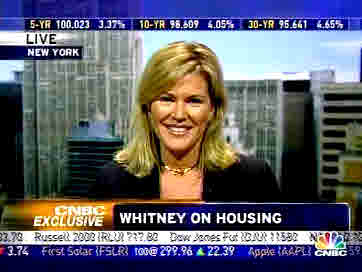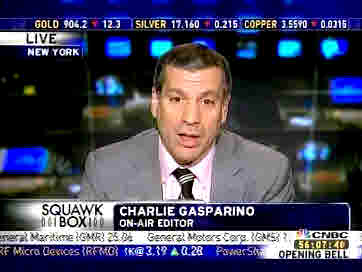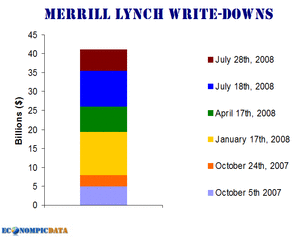
Dynamics

|
Generational Dynamics |
| Forecasting America's Destiny ... and the World's | |
| HOME WEB LOG COUNTRY WIKI COMMENT FORUM DOWNLOADS ABOUT | |
The new Merrill Lynch asset writedowns are triggering a race to the bottom.
 |
In March, Meredith Whitney, Oppenheimer's executive director of equity research, appearing on CNBC, said that banks have been trying to avoid having to write down their assets for as long as they can avoid it. But the longer they wait, the worse it is, because the mortgage-backed assets keep falling as time goes on.
Whitney went much farther -- she predicted a full-scale panic when banks finally are forced to mark these assets down. Because the market will be loaded down with these securities from all sorts of financial institutions, they really will be almost worthless.
Last Friday, National Australia Bank marked its CDOs down to 10% of their original nominal value. In writing about this markdown, I noted that the extraordinary size of the writedown might be the trigger that launches this panic.
On Monday, Merrill Lynch announced a large writedown of its CDOs to 22% of a portion of their CDO portfolio, originally valued at $30.1 billion, to $6.7 billion. They had already been written down to $11.1 billion during the second quarter, so Monday's action represents an additional $4.4 billion writedown.
On Wednesday, Whitney appeared again on CNBC, and indicated that she feels that her March prediction is in progress. In answer to the question, "Who's next?", she answered:
I think that Wachovia, not with the same exposures, will be in the market soon. ...
Look, these institutions are not alone, because everyone was involved in mortgages.
You know it's interesting ... how much of Wall Street banking revenues really gravitated towards the mortgage market. I mean these were lopsided business models. And because they're so levered in the mortgage market, they have so much downside to the mortgage market. And so I think we're going to see '25 plus' institutions come back for capital inside of the next two months."
These '25 plus' institutions, beginning with Citi and UBS, will be coming to the capital markets within the next two months because they'll be forced to write down their assets that are similar to those held by Merrill.
 |
When asked whether Lehman Brothers Holdings Inc. would even survive, she answered as follows, grinning:
Ummmmm, I think we get the message. Lehman Brothers is now the smallest Wall Street investment bank, ever since Bear Stearns collapsed in March, and investors have been fearing a collapse ever since.
When asked whether we've seen the worst of the credit crisis, she answered as follows:
And the valuations and the assumptions that companies are using and carrying assets, are still unrealistic.
The central root of all this issue is housing prices. House prices continue to decline, and these assets are valued at really aspirational values, so you're going to continue to be writedowns, capital will continue to be raised, recapitalizations by so many of the financial institutions, and the whole notion of equity is really designed to fund growth. This equity is just plugging holes. It's not funding any growth. And as a result, there's less and less lending available. And that means that there's more and more strain on businesses, and more and more strain on the consumer."
Once again, Whitney is not directly answering the question, but she's sending the message that there's much worse to come.
The appearance of a panicked sale was described earlier in the day by CNBC reporter Charlie Gasparino, who said the following about the Merrill Lynch deal:
But what was going on, and what has been going on recently, not just Monday, is growing trepidation among institutional clients about this continued drip of bad news. You put both of those things together, and from what I understand, sometime late last week, they just decided, let's pull the trigger.
They had this hedge fund, this Lone Star fund, willing to do the deal. They thought, OK, this is not the best deal -- this is heavily financed, there's a lot of bells and whistles to this, but we have the firm that's ready to do it, we could be the first out of the box.
I think one of the things that Merrill was worried about - was that if they weren't first out of the box, if they have to compete for selling this stuff with maybe a Lehman Brothers or a Citi, which holds similar assets, they wouldn't get as good a deal.
So they decided -- and from what I understand they worked the entire weekend -- to pull the trigger, and they got it done."
 |
There are a couple of interesting things about this statement.
The first is that it indicates that panicked selling was in play. Panicked selling occurs when people sell as quickly as possible, because they fear that prices are going to go even lower. That's what happens in a stock market crash, and Gasparino is describing it here in Merrill's case.
The second issue is one that nobody ever seems to mention these days (except of course for me on this web site).
Question: What's missing from the reasons reported by Gasparino for wanting to get the writedown out of the way?
Answer: What's missing is the reason that they should have written down these assets right away because it's the honest thing to do.
For those who aren't aware of it, banks are required to "mark to market" their assets, so that there assets are always valuated at the best possible price. There's no market for the CDOs, but there have been enough writedowns in the last few months so that it should be possible to determine that substantial writedowns must occur. Not doing so is fraud, because investors in the bank are fooled into thinking that the bank is worth more than it actually is worth. But let's face it. Fraud is OK these days because everybody is doing it, and because government officials are actively encouraging banks to do it.
 |
What did John Thain know, and when did he know it?
That's the question being asked by a lot of bloggers this week, referring to John Thain, the CEO of Merrill Lynch.
There have been a lot of writedowns, as the adjoining diagram shows. Each time a writedown occurs, there's a big announcement, and a promise that there won't be any more.
Here's how the EconomPicData blog describes the situation:
 |
On the other hand, there's a Reuters article that says that Thain's credibility survives:
So far, though, investors seem to be cutting him a fair amount of slack. In fact on Tuesday after John Thain's latest about-face, Merrill's shares rose 7.9 percent.
But patience for the former Goldman Sachs and NYSE executive's flip flops may wear thin, critics said.
"This may be the last time, or you could see more writedowns. You just don't know," said Jim Huguet, co-chief executive at fund manager Great Companies.
Merrill Lynch said on Monday it was raising $8.5 billion capital after agreeing to sell toxic debt assets at a loss.
The share sale comes less than two weeks after Thain said on a conference call with investors, "Right now, we believe we are in a very comfortable spot in terms of our capital."
Thain has been making positive statements about the bank's capital for months. In an April interview with Japan's Nihon Keizai Shimbun, Thain said, "The goal is to maintain our current ratings. No more capital raising; I'm sure we have enough capital."
I really have to laugh at this. How many flip-flops does a CEO have to make before his credibility "wears thin" enough to be un-credible?
If Thain or any of these CEOs at least made a gesture to their fiduciary, ethical and legal duties, by saying something like, "We wrote down these assets for many reasons, one of which is that we owe our investors and the public the truth" -- if one of them ever said something like that, I'd be so shocked, I might actually believe him.
But these guys are exhibiting no ethics whatsoever. If they ever tell the truth, it's because they have no choice or because they're trapped or because they accidentally stumble into it.
For a lengthier discussion of (lack of) ethics, read, "'Operation Malicious Mortgage' indicts 406 people including Bear Stearns execs."
(31-Jul-2008)
Permanent Link
Receive daily World View columns by e-mail
Donate to Generational Dynamics via PayPal
Web Log Summary - 2016
Web Log Summary - 2015
Web Log Summary - 2014
Web Log Summary - 2013
Web Log Summary - 2012
Web Log Summary - 2011
Web Log Summary - 2010
Web Log Summary - 2009
Web Log Summary - 2008
Web Log Summary - 2007
Web Log Summary - 2006
Web Log Summary - 2005
Web Log Summary - 2004
Web Log - December, 2016
Web Log - November, 2016
Web Log - October, 2016
Web Log - September, 2016
Web Log - August, 2016
Web Log - July, 2016
Web Log - June, 2016
Web Log - May, 2016
Web Log - April, 2016
Web Log - March, 2016
Web Log - February, 2016
Web Log - January, 2016
Web Log - December, 2015
Web Log - November, 2015
Web Log - October, 2015
Web Log - September, 2015
Web Log - August, 2015
Web Log - July, 2015
Web Log - June, 2015
Web Log - May, 2015
Web Log - April, 2015
Web Log - March, 2015
Web Log - February, 2015
Web Log - January, 2015
Web Log - December, 2014
Web Log - November, 2014
Web Log - October, 2014
Web Log - September, 2014
Web Log - August, 2014
Web Log - July, 2014
Web Log - June, 2014
Web Log - May, 2014
Web Log - April, 2014
Web Log - March, 2014
Web Log - February, 2014
Web Log - January, 2014
Web Log - December, 2013
Web Log - November, 2013
Web Log - October, 2013
Web Log - September, 2013
Web Log - August, 2013
Web Log - July, 2013
Web Log - June, 2013
Web Log - May, 2013
Web Log - April, 2013
Web Log - March, 2013
Web Log - February, 2013
Web Log - January, 2013
Web Log - December, 2012
Web Log - November, 2012
Web Log - October, 2012
Web Log - September, 2012
Web Log - August, 2012
Web Log - July, 2012
Web Log - June, 2012
Web Log - May, 2012
Web Log - April, 2012
Web Log - March, 2012
Web Log - February, 2012
Web Log - January, 2012
Web Log - December, 2011
Web Log - November, 2011
Web Log - October, 2011
Web Log - September, 2011
Web Log - August, 2011
Web Log - July, 2011
Web Log - June, 2011
Web Log - May, 2011
Web Log - April, 2011
Web Log - March, 2011
Web Log - February, 2011
Web Log - January, 2011
Web Log - December, 2010
Web Log - November, 2010
Web Log - October, 2010
Web Log - September, 2010
Web Log - August, 2010
Web Log - July, 2010
Web Log - June, 2010
Web Log - May, 2010
Web Log - April, 2010
Web Log - March, 2010
Web Log - February, 2010
Web Log - January, 2010
Web Log - December, 2009
Web Log - November, 2009
Web Log - October, 2009
Web Log - September, 2009
Web Log - August, 2009
Web Log - July, 2009
Web Log - June, 2009
Web Log - May, 2009
Web Log - April, 2009
Web Log - March, 2009
Web Log - February, 2009
Web Log - January, 2009
Web Log - December, 2008
Web Log - November, 2008
Web Log - October, 2008
Web Log - September, 2008
Web Log - August, 2008
Web Log - July, 2008
Web Log - June, 2008
Web Log - May, 2008
Web Log - April, 2008
Web Log - March, 2008
Web Log - February, 2008
Web Log - January, 2008
Web Log - December, 2007
Web Log - November, 2007
Web Log - October, 2007
Web Log - September, 2007
Web Log - August, 2007
Web Log - July, 2007
Web Log - June, 2007
Web Log - May, 2007
Web Log - April, 2007
Web Log - March, 2007
Web Log - February, 2007
Web Log - January, 2007
Web Log - December, 2006
Web Log - November, 2006
Web Log - October, 2006
Web Log - September, 2006
Web Log - August, 2006
Web Log - July, 2006
Web Log - June, 2006
Web Log - May, 2006
Web Log - April, 2006
Web Log - March, 2006
Web Log - February, 2006
Web Log - January, 2006
Web Log - December, 2005
Web Log - November, 2005
Web Log - October, 2005
Web Log - September, 2005
Web Log - August, 2005
Web Log - July, 2005
Web Log - June, 2005
Web Log - May, 2005
Web Log - April, 2005
Web Log - March, 2005
Web Log - February, 2005
Web Log - January, 2005
Web Log - December, 2004
Web Log - November, 2004
Web Log - October, 2004
Web Log - September, 2004
Web Log - August, 2004
Web Log - July, 2004
Web Log - June, 2004